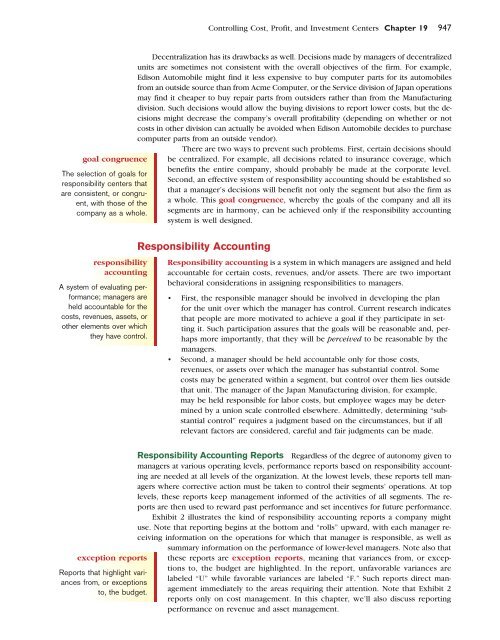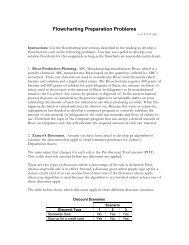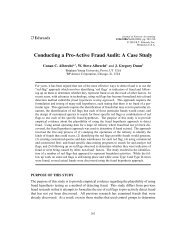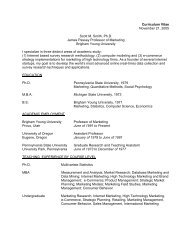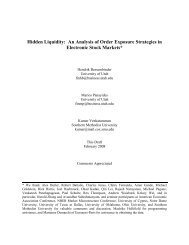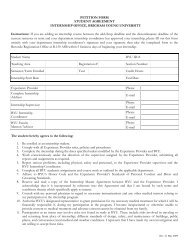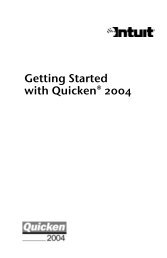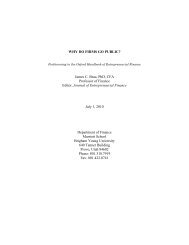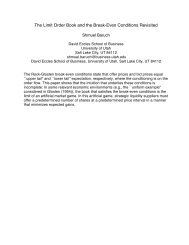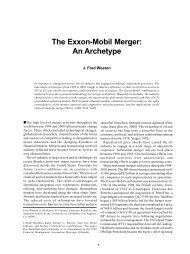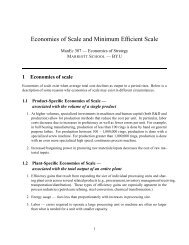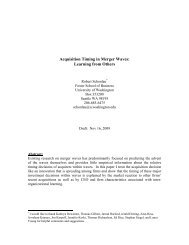Albrecht 19.pdf - Marriott School
Albrecht 19.pdf - Marriott School
Albrecht 19.pdf - Marriott School
You also want an ePaper? Increase the reach of your titles
YUMPU automatically turns print PDFs into web optimized ePapers that Google loves.
76154_23_ch19_p942-1006.qxd 3/1/07 3:35 PM Page 947<br />
Controlling Cost, Profit, and Investment Centers Chapter 19 947<br />
goal congruence<br />
The selection of goals for<br />
responsibility centers that<br />
are consistent, or congruent,<br />
with those of the<br />
company as a whole.<br />
Decentralization has its drawbacks as well. Decisions made by managers of decentralized<br />
units are sometimes not consistent with the overall objectives of the firm. For example,<br />
Edison Automobile might find it less expensive to buy computer parts for its automobiles<br />
from an outside source than from Acme Computer, or the Service division of Japan operations<br />
may find it cheaper to buy repair parts from outsiders rather than from the Manufacturing<br />
division. Such decisions would allow the buying divisions to report lower costs, but the decisions<br />
might decrease the company’s overall profitability (depending on whether or not<br />
costs in other division can actually be avoided when Edison Automobile decides to purchase<br />
computer parts from an outside vendor).<br />
There are two ways to prevent such problems. First, certain decisions should<br />
be centralized. For example, all decisions related to insurance coverage, which<br />
benefits the entire company, should probably be made at the corporate level.<br />
Second, an effective system of responsibility accounting should be established so<br />
that a manager’s decisions will benefit not only the segment but also the firm as<br />
a whole. This goal congruence, whereby the goals of the company and all its<br />
segments are in harmony, can be achieved only if the responsibility accounting<br />
system is well designed.<br />
responsibility<br />
accounting<br />
A system of evaluating performance;<br />
managers are<br />
held accountable for the<br />
costs, revenues, assets, or<br />
other elements over which<br />
they have control.<br />
exception reports<br />
Reports that highlight variances<br />
from, or exceptions<br />
to, the budget.<br />
Responsibility Accounting<br />
Responsibility accounting is a system in which managers are assigned and held<br />
accountable for certain costs, revenues, and/or assets. There are two important<br />
behavioral considerations in assigning responsibilities to managers.<br />
• First, the responsible manager should be involved in developing the plan<br />
for the unit over which the manager has control. Current research indicates<br />
that people are more motivated to achieve a goal if they participate in setting<br />
it. Such participation assures that the goals will be reasonable and, perhaps<br />
more importantly, that they will be perceived to be reasonable by the<br />
managers.<br />
• Second, a manager should be held accountable only for those costs,<br />
revenues, or assets over which the manager has substantial control. Some<br />
costs may be generated within a segment, but control over them lies outside<br />
that unit. The manager of the Japan Manufacturing division, for example,<br />
may be held responsible for labor costs, but employee wages may be determined<br />
by a union scale controlled elsewhere. Admittedly, determining “substantial<br />
control” requires a judgment based on the circumstances, but if all<br />
relevant factors are considered, careful and fair judgments can be made.<br />
Responsibility Accounting Reports Regardless of the degree of autonomy given to<br />
managers at various operating levels, performance reports based on responsibility accounting<br />
are needed at all levels of the organization. At the lowest levels, these reports tell managers<br />
where corrective action must be taken to control their segments’ operations. At top<br />
levels, these reports keep management informed of the activities of all segments. The reports<br />
are then used to reward past performance and set incentives for future performance.<br />
Exhibit 2 illustrates the kind of responsibility accounting reports a company might<br />
use. Note that reporting begins at the bottom and “rolls” upward, with each manager receiving<br />
information on the operations for which that manager is responsible, as well as<br />
summary information on the performance of lower-level managers. Note also that<br />
these reports are exception reports, meaning that variances from, or exceptions<br />
to, the budget are highlighted. In the report, unfavorable variances are<br />
labeled “U” while favorable variances are labeled “F.” Such reports direct management<br />
immediately to the areas requiring their attention. Note that Exhibit 2<br />
reports only on cost management. In this chapter, we’ll also discuss reporting<br />
performance on revenue and asset management.


